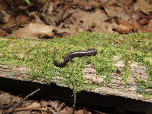 |
Shenandoah Mountain Salamander Range Map
|
|
|
 |
 |
 |
 |
 |
 |
 |
Shenandoah Mountain Salamander Juvenile

|
|
|
 |
 |
 |
 |
 |
 |
|
Shenandoah Mountain Salamander (Plethodon virginia)
Description: Up to 5.4 inches. This is an elongated salamander with short legs and a tail longer than the body. Throat is white with a belly that is black with some white and brown mottling. The Shenandoah Mountain Salamander and the Valley and Ridge Salamander can only be distinguished by either genetics or geographic location.
Habitat: The habitat of Shenandoah Mountain salamanders at a site in Rockingham County, Virginia, includes ridges and slopes. The ridges are characterized by deep soil with a predominant vegetation of white oak (Quercus alba), pink honeysuckle (Rhododendren nudifolium), and late low blueberry (Vaccinium vacillans). The slopes are characterized by shallow, rocky soil with a predominant vegetation of chestnut oak (Quercus montanta), red maple (Acer rubrum), late low blueberry, witch hazel (Hamamelis virginiana<.i>), and mountain laurel (Kalmia latifolia). Farther down the slopes, the soil is rocky with exposed bedrock and a predominate vegetation of chestnut oak, red oak (Quercus rubra), bitternut hickory (Carya cordiformis), black gum (Nyssa sylvatica), and witch hazel.
Range: The species is endemic to Shenandoah Mountain, South Branch Mountain and Nathaniel Mountain of the Appalachian Mountains, in eastern West Virginia and adjacent northwestern Virginia. Its natural habitat is temperate forests between 1,600 and 3,900 feet in elevation.
Found in these States:
VA |
WV
Diet: Main food items in the stomachs of Shenandoah Mountain salamanders includes Hymenoptera, Collembola, Chilopoda, Diplopoda, Araneida, and larval Diptera, Oligochaeta, Coleoptera, and Pulmonata.
Reproduction: Egg deposition sites are unknown, but as with other members of the P. cinereus group, likely to include underground sites and perhaps sites under surface cover objects. The average number of eggs was 4.6, deposited by five female Shenandoah Mountain salamanders in Rockingham County, Virginia.
Status: Listed as Near Threatened since this species is relatively range-restricted and likely occurs at five or fewer threat-defined locations. Deforestation in the surrounding area as well as the predicted consequences of climate change may lead to loss and degradation of suitable habitats in the future, which would result in an uplisting to Vulnerable or Endangered.
»» Kingdom: Animalia - Animals
»» Phylum: Chordata - Chordates
»» Subphylum: Vertebrata - Vertebrates
»» Class: Amphibia - (Amphibians)
»» Order: Caudata - Salamanders
»» Family: Plethodontidae - Lungless Salamanders
»» Genus: Plethodon
»» Species: Plethodon virginia - Shenandoah Mountain Salamander
This article uses material from the Wikipedia article "Shenandoah Mountain Salamander", which is released under the Creative Commons Attribution-Share-Alike License 3.0. Content may have been omitted from the original, but no content has been changed or extended.
|
|








